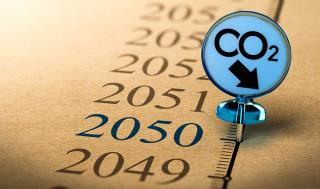In the last week a report by Robert Andrew, an emissions scientist for Global Carbon Project and CICERO Centre for International Climate Research in Norway, has disclosed that CO2 emissions from chemical and industrial processes used to manufacture cement have risen from 1.2bnt in 2002 to 2.6bnt in 2021. According to his analysis, he argues, the current decarbonisation policies of cement producers have not yet had the necessary impact to start reducing global carbon emissions. Instead, emissions from the sector have doubled according to this data. It is going to need a vast turnaround in performance to cut CO2 emissions by a quarter by 2030, as proposed in the Global Cement and Concrete Association’s (GCCA) Roadmap.
The International Energy Agency’s (IEA) industry analysis from 2021 announced the average emission generated per tonne of cement production is also rising and was 9.3 per cent higher in 2020 than it had been in 2015. With China producing more than half (around 55 per cent) of the world’s cement based on coal firing, the IEA attributes much of the rise in CO2 from the industry to this. China also will not peak in its CO2 emissions from cement production until 2023. Of the top 10 producing Chinese cement companies, only Taiwan Cement had committed to making any CO2 cuts by 2025, 2030 and 2050, according to Global Energy Monitor. But other countries are also falling behind including US, India, Vietnam and Turkey.
As of December 2020, the Transitional Pathways Initiative assessed that 33 cement producers in the world had targeted net zero by 2050, among them CRH, HeidelbergCement, Cemex, Dalmia Bharat, Taiheiyo Cement, Holcim and UltraTech Cement.
New decarbonisation solutions required
The industry is expected to bring carbon capture utilisation and storage (CCUS) facilities into play by 2030, but even this is only predicted to capture 36 per cent of the global sector’s CO2 emissions by 2050, claims sustainable leaders forum edie. Other solutions are required in addition to more energy efficient plants, including circular economy raw materials, reduced clinker content, low-carbon fuels, calcined clay cements, supplementary cementitious materials, electrifying processes as well as carbon capture and CCUS.
Are governments doing enough?
Last week also saw the ‘Low-carbon concrete and construction – A review of green public procurement programmes’ report from released by the World Economic Forum and the GCCA in collaboration with Boston Consulting Group. It is significant for establishing standards for reporting CO2 emissions, databases and tools for tracking emissions as well as establishing baselines. The second part of the report looks at procurement policies with environmental disclosures, mandated carbon limits and incentivised low-carbon design and use of low-carbon materials. The authors of the report want to support governments in making the right choices about how to implement standards and implement green public procurement of construction projects. Focussing on the six countries of The Netherlands, Germany, Sweden, France, the UK and USA where low-carbon concrete is a priority, the authors call upon global green construction guidelines, disclosure of embodied carbon in buildings and incentivised government procurement of low-carbon design.
It’s not enough for the private sector to determine the speed of decarbonisation
In March 2022 the Cement Science Based Target Initiative's (SBTi) guidance document called for a sectoral decarbonisation approach. It argued that for the cement sector to reach net-zero by 2050, "we need a race to the top, led by pioneering companies cross the industry". The SBTi determines that to align with the 1.5˚C Paris Agreement temperature rise for this century, cumulative 2020-50 CO2 emissions for the cement sector require 31-41Gt of CO2 removal.
The need for breakthrough technologies is upon us. Some solutions are already being defined through new ways of producing cement, such as Breakthrough Energy’s CHEMent patent-pending technology that employs a room temperature electrochemical process to eliminate 50 per cent of CO2 emissions. Hoffmann Green cement similarly uses a cold manufacturing process that does not use clinker but synthetic use of abundant co-products such as slag, clay and gypsum that are mixed with the company’s activators.
Summary
While ordinary Portland cement (CEM I) will remain in production past 2050, the pressure is on to find alternatives that can produce the same or better performance with reduced CO2 emissions. Most of the decarbonisation levers found in the GCCA’s 2050 Net Zero Roadmap will be employed to good effect, including CCUS from 2030. However, today the industry continues to release CO2 at unprecedented levels and breakthrough technologies will require further investment to uncover solutions to meet the net zero target in 2050.


